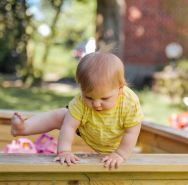
While you hope nothing ever happens, it’s important to child-proof a house for potential injuries just in case. It’s always better to be safe than sorry! The safety hazards room by room walk-about activity is an engaging way to brainstorm and get students up, out of their seats, critically thinking, communicating and collaborating with their peers.
Set
- Ask students if any of them were ever accident prone? Did any their parents ever wish for them to be safer like in this Toyota commercial?
- While bubble wrap may seem like a great way to “protect” a child, it’s not really practical to everyday living or life.
- Ask students if the accidents they experienced as youngsters could have been prevented and how.
Materials
- Butcher paper or Large pieces of construction paper
- Markers & Tape
Activities
- Label large pieces of construction paper with rooms of the house and hang them around the classroom. Rooms include: Kitchen, Bathroom, Bedrooms (parent & child), Living/Family Room, Garage/Basement and Outdoor Area. Note: You want to make sure in the end that you have the same number of posters as you do groups of students. For example, if I want six groups of students, then I need to decide which 6 rooms I’m going to use as labels.
- Provide each student with a colored marker and have them circulate and add a “new or different” hazardous object that can be found in each room of the house (no repeats). Students must also initial their responses so I know everyone has added an idea.
- Break students into 6 small groups and provide them with a “room of the house” and have them explain the accident(s) that could happen with each object “bubble or mind map style”. Again, you can adjust the number of groups based on your class size…just be sure you have the same number of room posters.
- Then, rotate the rooms between the groups, asking each to solve a certain number of hazards…what can be done to prevent this from becoming a serious injury or accident. This way each group contributes to the hazards/prevention of each room.
- Ex. Object=Uncovered Electrical Outlet & Injury=Electrocution or Shock & Prevention= Covered outlets with safety plugs or blocking with heavy furniture.
- Discuss and process the results, sharing a variety of objects, injuries and ways to prevent. If you have any safety devices from your own home, this would be a great place to show them off or demonstrate how they work.
- Finally, have students complete the 3-2-1 reflection on Google Classroom using the following prompts:
- What do you believe to be the 3 most dangerous rooms in a house?
- Share 2 objects or accidents that you never considered before this activity.
- Explain 1 major reason why it’s important to safety proof your house when you have young children.
Similar Lessons
Photo by Alexander Dummer on Unsplash

